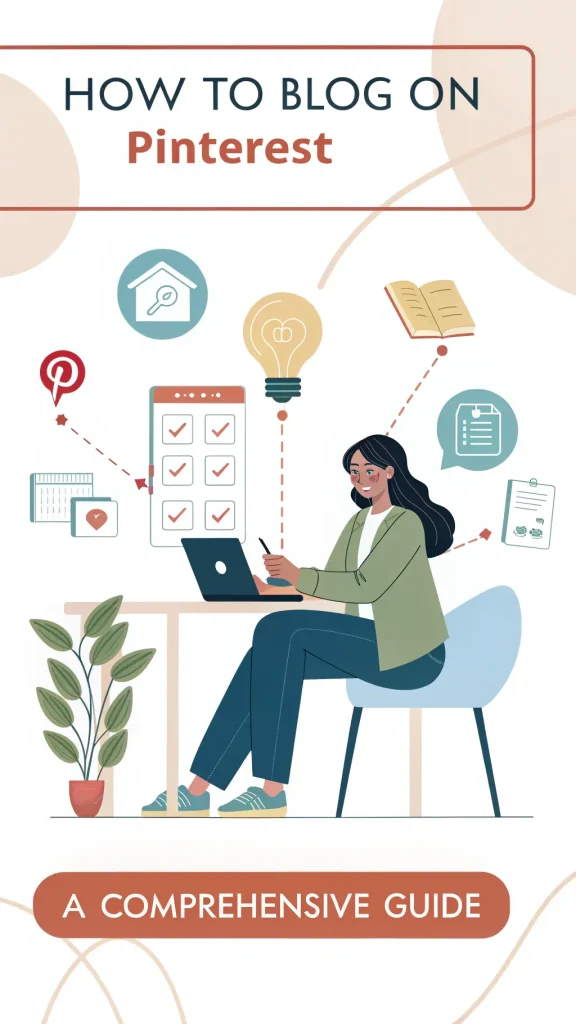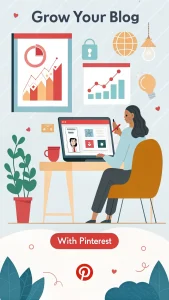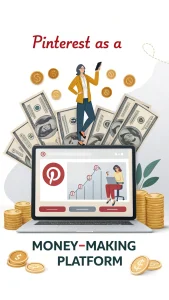Pinterest Comprehensive Guide

Introduction: Why Pinterest is a Powerful Blogging Platform
Pinterest, a dynamic platform blending social media and visual search, boasts a user base renowned for its purchasing power and intent. Unlike other platforms, Pinterest users actively search for ideas and inspiration, making it a prime location for bloggers to connect with their target audience. Leveraging Pinterest for your blog can significantly increase website traffic, boost brand awareness, and generate valuable leads. Forget the misconception that Pinterest is just for recipes and DIY crafts; it’s a powerful tool for any blogger looking to expand their reach and connect with a highly engaged audience.
Setting Up Your Pinterest for Blogging Success
Creating a Business Account vs. Personal Account: benefits and differences
A Pinterest Business account unlocks essential features like analytics and advertising tools, crucial for bloggers serious about content marketing. While a personal account is fine for casual use, a Business account offers valuable insights into pin performance and audience engagement, empowering you to refine your Pinterest strategy for optimal results.
Optimizing your Pinterest Profile
Optimizing your Pinterest profile is essential for attracting your target audience. Choose a clear, relevant profile name and username, and craft a keyword-rich business description that accurately reflects your blog’s niche. Use a professional-looking profile picture, ideally your logo, and prominently display your website link. Claiming your website and other social media profiles adds credibility and makes it easier for users to connect with you across different platforms.
Creating Niche-Specific Boards
Organizing your pins into niche-specific boards enhances user experience and improves searchability. Conduct keyword research to determine the most relevant terms for your board names and descriptions. Create a variety of boards showcasing different aspects of your blog, such as product boards, blog post boards, and inspiration boards, to cater to diverse interests within your niche.
Crafting Irresistible Pins for Your Blog Posts
Understanding Pinterest Image Specifications
Pinterest’s visual nature emphasizes the importance of high-quality, correctly sized images. Adhering to optimal dimensions and file types ensures your pins look professional and are readily shareable. Use vertical images (a 2:3 aspect ratio is recommended) for maximum impact in the Pinterest feed.
Designing Visually Appealing Pins
Captivating visuals are key to grabbing attention on Pinterest. Use high-resolution images and graphics, incorporating text overlays with clear fonts and concise messaging that conveys the essence of your blog post. Maintain consistent branding elements, like your brand colors and logo, to reinforce brand recognition.
Explore different pin formats like static images, videos, GIFs, and Idea Pins to diversify your content and cater to different user preferences. Each format offers unique opportunities to engage your audience and showcase your blog’s content in a creative way.
Writing Compelling Pin Descriptions
While visuals are paramount, compelling pin descriptions are crucial for providing context and driving clicks. Incorporate relevant keywords naturally into your descriptions, and always include a clear call to action, encouraging users to click through to your blog post. Utilize relevant hashtags to increase discoverability, and always include a direct link to your blog post to make it easy for users to access your content.
Creating Blog Content Tailored for Pinterest
Keyword Research for Pinterest
Understanding what your target audience is searching for on Pinterest is essential for creating relevant and engaging content. Utilize Pinterest’s search bar and keyword research tools to identify popular keywords and phrases related to your blog’s niche.
Integrating Keywords into Blog Posts
Seamlessly integrating relevant keywords into your blog posts improves their visibility on Pinterest and search engines. Naturally incorporate keywords within your content and image alt text to enhance SEO and attract the right audience.
Creating Pin-Worthy Images Within Your Blog Posts
Make it easy for readers to share your content on Pinterest by including visually appealing, pin-worthy images within your blog posts. Use design tools like Canva to create multiple images for each post, catering to different aspects of your content and providing visual variety.
Adding a Pinterest “Save” Button to Your Blog
Encourage readers to share your content on Pinterest by adding a “Save” button to your blog. This simple addition makes it effortless for users to pin your images and drive traffic back to your website.
Pinterest SEO: Optimizing for Search and Discovery
Keyword Optimization for Pinterest
Strategic keyword optimization is crucial for maximizing your visibility on Pinterest. Incorporate relevant keywords into your board names, descriptions, pin titles, and descriptions to ensure your content appears in relevant searches.
Hashtag Strategy
Using a mix of broad and niche-specific hashtags expands your reach and connects you with a wider audience. Research relevant hashtags within your niche and experiment to see which ones perform best for your content.
Rich Pins
Setting up rich pins provides additional context and information about your content, making your pins more appealing and informative. Rich pins for articles, products, and recipes enhance user experience and drive clicks.
Following Best Practices for Pinterest SEO
Staying informed about Pinterest’s algorithm changes and best practices is crucial for maintaining optimal performance. Keep up-to-date with the latest recommendations to ensure your Pinterest strategy remains effective and aligned with the platform’s evolving landscape.
Promoting Your Blog Posts on Pinterest
Creating a Pinterest Marketing Strategy
A well-defined Pinterest marketing strategy provides direction and focus for your efforts. Establish clear goals for your Pinterest presence, such as increasing website traffic or brand awareness, and identify your target audience to tailor your content accordingly.
Pinning Consistently
Regular pinning is essential for maintaining an active presence on Pinterest and reaching a wider audience. Use a scheduling tool like Tailwind or Pinterest’s built-in scheduler to streamline your pinning schedule and ensure consistent content delivery.
Joining Group Boards
Collaborating with other pinners by joining group boards expands your reach and exposes your content to a new audience. Identify relevant group boards within your niche and actively participate to gain exposure and build connections.
Running Pinterest Ads
Pinterest Ads offer a targeted approach to promoting your blog posts and reaching a wider audience. Utilize Pinterest’s advertising platform to boost specific pins and drive traffic directly to your blog.
Engaging with Your Audience
Building a loyal Pinterest following involves actively engaging with your audience. Respond to comments, follow relevant users, and participate in community discussions to foster connections and build relationships.
Analyzing and Tracking Your Pinterest Performance
Using Pinterest Analytics
Pinterest Analytics provides valuable insights into your pin performance and audience engagement. Monitor key metrics like impressions, saves, and clicks to understand what resonates with your audience and refine your strategy accordingly.
Tracking Website Traffic from Pinterest
Utilize Google Analytics to track website traffic originating from Pinterest. This data helps you measure the effectiveness of your Pinterest marketing efforts and identify areas for improvement.
A/B Testing Your Pins
Experiment with different image styles, descriptions, and calls to action to determine what performs best. A/B testing allows you to optimize your pins for maximum engagement and clicks.
Adapting Your Strategy Based on Results
Continuously analyze your Pinterest performance and adapt your strategy based on the data you gather. Flexibility and responsiveness to changing trends and audience preferences are key to long-term success on Pinterest.
Advanced Pinterest Strategies for Bloggers
Idea Pins
Idea Pins offer a dynamic way to engage your audience with multi-page content. Utilize this format to create visually rich stories, tutorials, or behind-the-scenes glimpses into your blog.
Video Pins
Leverage the power of video marketing with engaging video pins. Create short, informative videos that capture attention and convey your message effectively.
Pinterest Shopping
If you sell products, setting up a product catalog and shoppable pins allows users to purchase directly through Pinterest. Streamline the buying process and make it easy for users to convert.
Collaborating with Brands and Influencers
Partnering with brands and influencers within your niche expands your reach and introduces your blog to a new audience. Collaborative campaigns can generate significant exposure and boost your credibility.
Utilizing Pinterest Trends
Staying ahead of the curve and capitalizing on popular topics allows you to tap into current trends and capture audience interest. Monitor Pinterest Trends to identify emerging topics and incorporate them into your content strategy.
Case Studies: Successful Bloggers on Pinterest
(Include specific examples of bloggers who have successfully used Pinterest, highlighting their strategies and results. This section would benefit from real-life examples and data.)
Future of Pinterest for Bloggers
(Discuss emerging trends and features on Pinterest and speculate on how the platform will continue to evolve for content marketing.)
Conclusion: Embracing the Power of Pinterest for Your Blog
Pinterest offers immense potential for bloggers looking to expand their reach, drive traffic, and build a loyal following. By implementing the strategies outlined in this guide, you can unlock the power of Pinterest and transform your blog into a thriving online destination. Start optimizing your Pinterest presence today and watch your blog flourish.
Frequently Asked Questions
Q: How often should I pin on Pinterest?
A: Consistency is key. Aim for several pins per day, spread throughout the day, to maximize your reach and engagement. Using a scheduling tool can help automate this process.
Q: What are the best image sizes for Pinterest?
A: A 2:3 aspect ratio (e.g., 1000px x 1500px) is recommended for vertical images, which perform best on Pinterest.
Q: How do I use hashtags effectively on Pinterest?
A: Use a mix of broad and niche-specific hashtags to reach a wider audience. Don’t overdo it – a few relevant hashtags per pin are sufficient.
Q: What are Rich Pins and how do I set them up?
A: Rich Pins provide additional context and information about your content. You can set them up by claiming your website on Pinterest and adding some code to your website’s header.
Q: How can I track the success of my Pinterest marketing efforts?
A: Use Pinterest Analytics and Google Analytics to track key metrics like impressions, saves, clicks, and website traffic originating from Pinterest.
Q: What are Idea Pins and how can I use them?
A: Idea Pins are multi-page pins that allow you to create engaging visual stories. Use them for tutorials, behind-the-scenes content, or product showcases.
Q: How can I get more followers on Pinterest?
A: Create high-quality, engaging content, follow relevant users, join group boards, and promote your Pinterest profile on other social media platforms.
Q: How can I use Pinterest to drive sales for my business?
A: Set up a product catalog and shoppable pins, create visually appealing product pins, and run targeted Pinterest Ads to reach potential customers.
Q: Can I collaborate with brands on Pinterest?
A: Yes! Reach out to brands within your niche and propose collaborative campaigns that benefit both parties.
Q: What’s the best way to stay up-to-date with Pinterest’s best practices?
A: Follow the official Pinterest blog, attend webinars, and participate in online communities to stay informed about the latest updates and best practices.


